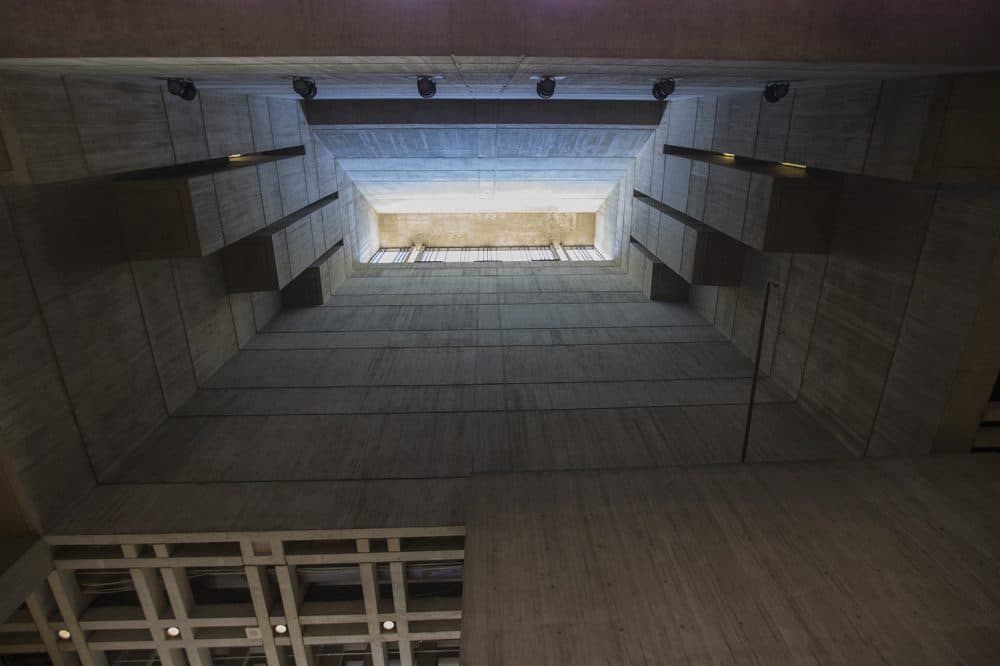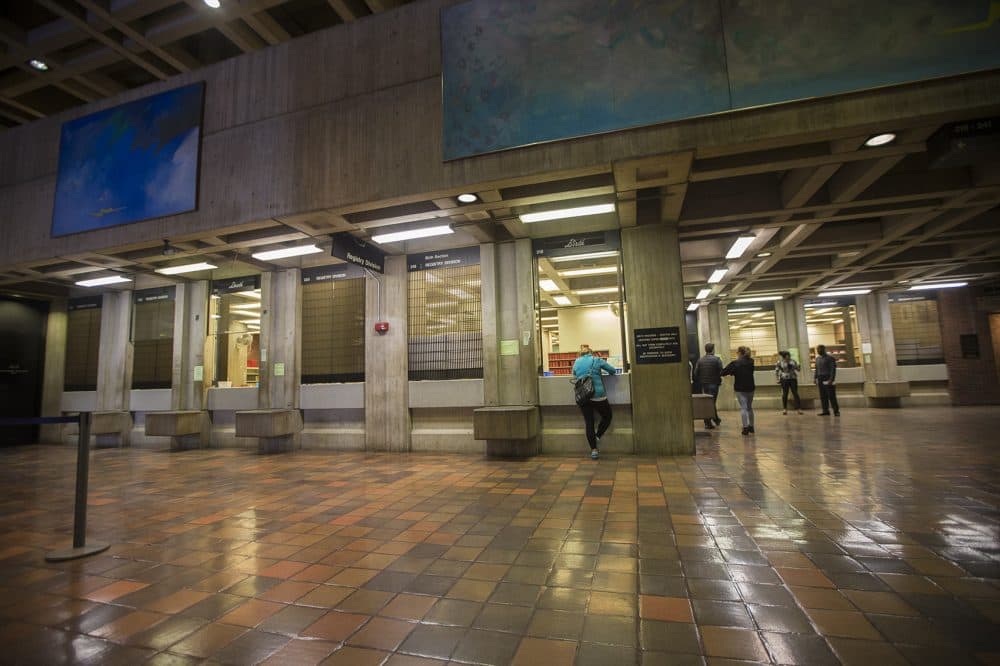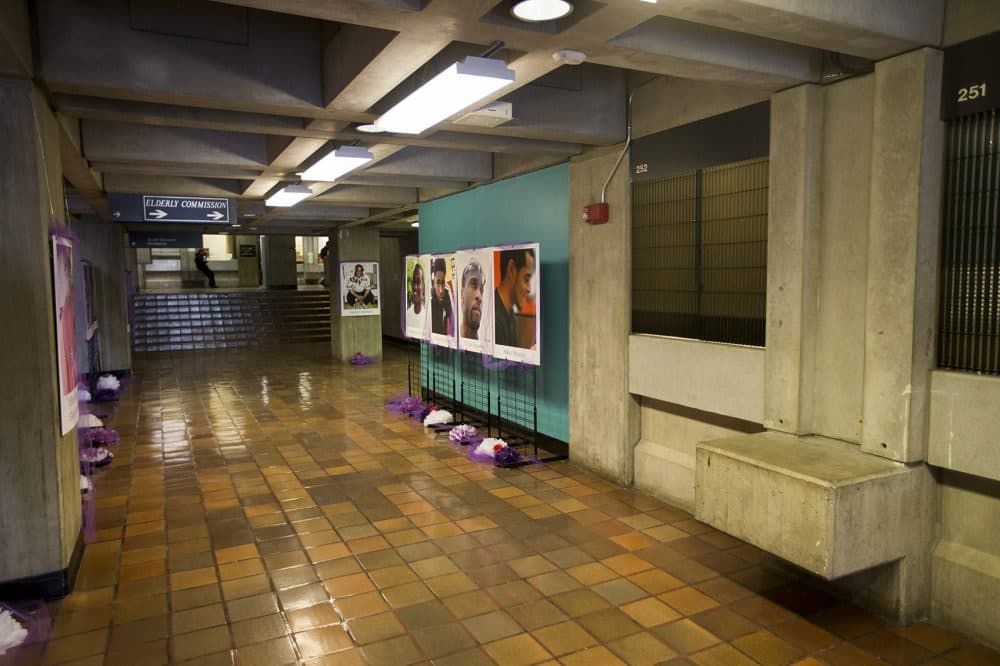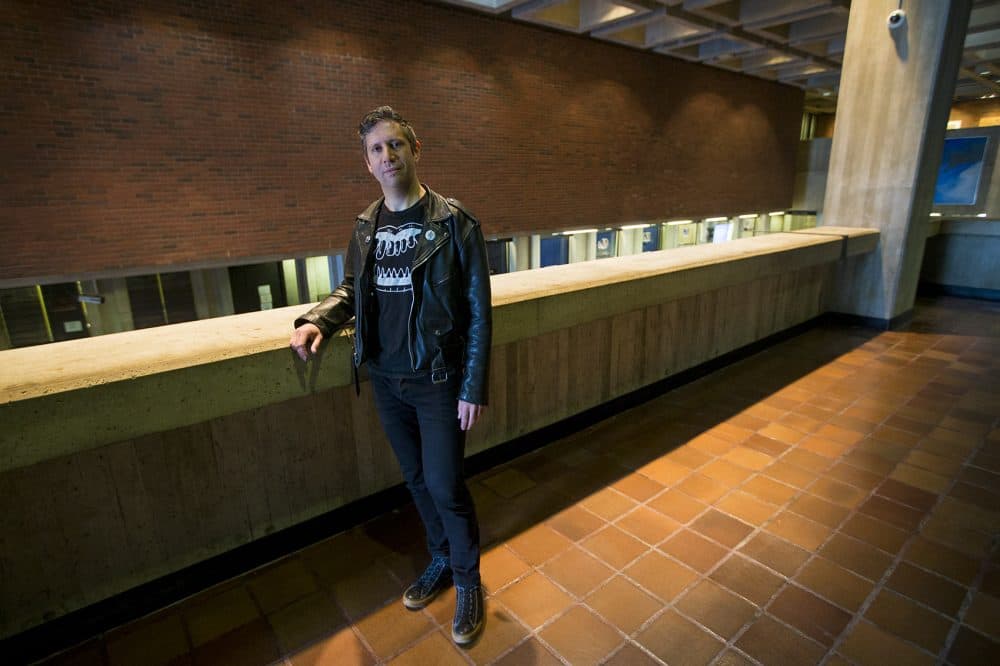Advertisement
To Some, Boston City Hall Is An Eyesore. To These Artists, It's Inspiration

Marilyn Arsem stands in Boston City Hall’s airy front lobby. She tips her head back to take in the vast concrete expanse that soars nine stories overhead, to a hazy shaft of sunlight at the top. “Straight up, open,” she says, with a touch of awe. “I love the windows at the top." Arsem points to a chiseled protrusion about halfway up the wall, wondering what it would be like if there were a place to stand on that overhang.
She is a member of the Boston-based experimental art collective Mobius. On May 25, the group will transform City Hall’s solemn gray interior with an elaborate art installation involving 13 artists in practically as many mediums -- no small task, considering the building's reputation as one of the ugliest buildings in the city.

Arsem is joined by fellow Mobius member Jane Wang, who describes a piece by the artists Joanne Rice and Tom Plsek involving trombone, tap shoes and jump rope. “[Rice will] be jump roping, while [Plsek] is with a trombone, and he’ll start on the fifth floor," Wang says. "So they’re going to be playing off each other with the acoustics.”
Another piece, by the performance artist Sandrine Schaefer, will tinker with the speed of the building’s escalators to upend visitors’ sense of time, while, elsewhere in the building, Wang knits an abstract wire sculpture over the course of the four-hour-long event. One of her videos, which features crowd-sourced imagery by 95 artists and original music by 21 composers, will be projected onto an ordinarily unassuming brick wall in the lobby.
For Wang, who grew up in the Boston area, curating the performances has changed her perception of the building — at least somewhat.
“Even though I still — I have to admit, I still think this building is pretty ugly, I feel a fondness for it now,” she says. “It has a lot of personality. It’s just when you, just, look at this big cement thing, it just feels very heavy. But when you come in here, and once you start to appreciate just pockets of it, I think you can see the beauty in it. So it's an ugly, beautiful thing.”
"Once you start to appreciate just pockets of it, I think you can see the beauty in it. So it's an ugly, beautiful thing."
Jane Wang
City registrar Patty McMahon, who has worked in Boston City Hall for nearly 30 years in various roles, knows the building’s reputation better than anyone. “Wet cement, hideous — a lot of different words I’ve heard people say,” she says with a chuckle.
The concrete style, commonly known as Brutalist, was popular in the ‘60s when it was built, but McMahon says the design is impractical. It’s difficult to hang pictures on the hard cement walls. Wires and piping hang exposed. And on the first floor where she works, there are no windows. McMahon says that each administration has taken a different tack with the building.
“I think at first initially it was to make it livable,” she says. “And then it was, in the Menino administration, to make it have wires and run, so you could actually use technology. And I think in the Walsh administration it’s really looked at, how do you actually make it pretty, and comfortable and light.”

That work is part of a city planning initiative aimed at reimagining the building called Rethink City Hall. Chris Grimley, of the design firm over,under, is a historical consultant on the project. In his office in South End, he leans over a map of the building and describes how the layout was meant to foster a sense of porousness and accessibility.
“You used to be able to come out, walk up into this atrium and then down the stair and across the street,” he explains. “You could come in this way, go up into the atrium, walk back out that way.”
With its deep-set windows and towering concrete brow, City Hall can seem fortress-like and forbidding. But Grimley says the design was rooted in high-minded democratic ideals, part of a huge, and successful, urban renewal project that revitalized Boston’s decaying downtown and restored faith in a government once riddled by corruption. City Hall was designed to be welcoming, transparent — a place for the public to gather.
Advertisement
“For instance, people don't realize that you could walk from the Government Center T stop, down the plaza, up into the courtyard,” Grimley says. “There is an elevated courtyard that exists in the center of the building, which is a completely remarkable space, which has skylights that flood the space below.”
Grimley says that over the years, the building has suffered from neglect. And now, for security reasons, there is only one point of entry — the front door — something not likely to change in our post-9/11 world.
But Grimley believes the civic spirit of the building can still be recaptured. And that’s where Mobius comes in.
“I am building this sort of tentacular, low-level inflatable sculpture that sort of seeps over the edge and oozes out onto the floor,” says artist Jesse Kaminsky.

Standing on a mezzanine overlooking a hallway in City Hall, he points to the ledge where he plans to install the sculpture — a huge, puffy anemone made of colorful Tyvek that undulates with the aid of a fan. Inspired by the artist’s love of early science fiction movies, the creature will creep over the edge of the balcony, infusing somber City Hall with a feeling of comical unease.
The piece is meant to contrast with the building’s severity and disrupt its sense of order. “I wanted to make this sculpture that was very soft and very floppy and forgiving — and kind of funny, in a way,” Kaminsky explains. Though he has great aspirations for his piece, he admits that it may not turn out the way he intended at all — something that could easily apply to the design of the building itself.
That's precisely what attracts him to the project. “I feel honored to be able to come into this area and bring in something that is not a sure thing,” Kaminsky says. “Because I think failure and that sort of possibility of failure is super important in the creative process — and in the municipal process as well, even though it's harder to admit that.”
To some, City Hall represents just that: a failure. But to the artists of Mobius, it has become a source of inspiration, even beauty — proof that Boston City Hall, in all its flaws and peculiarities, might still be worthy of love.
This segment aired on May 19, 2017.
